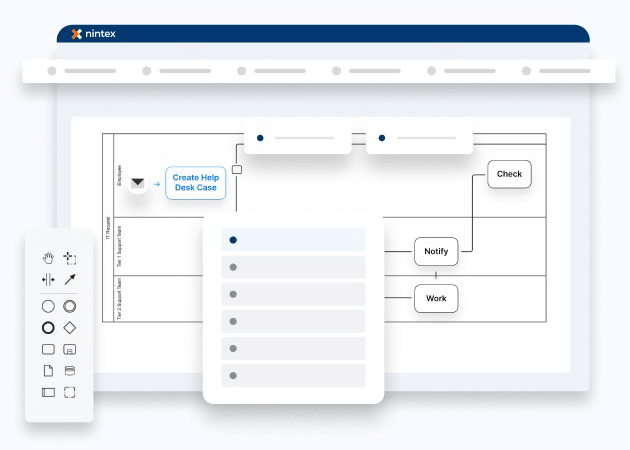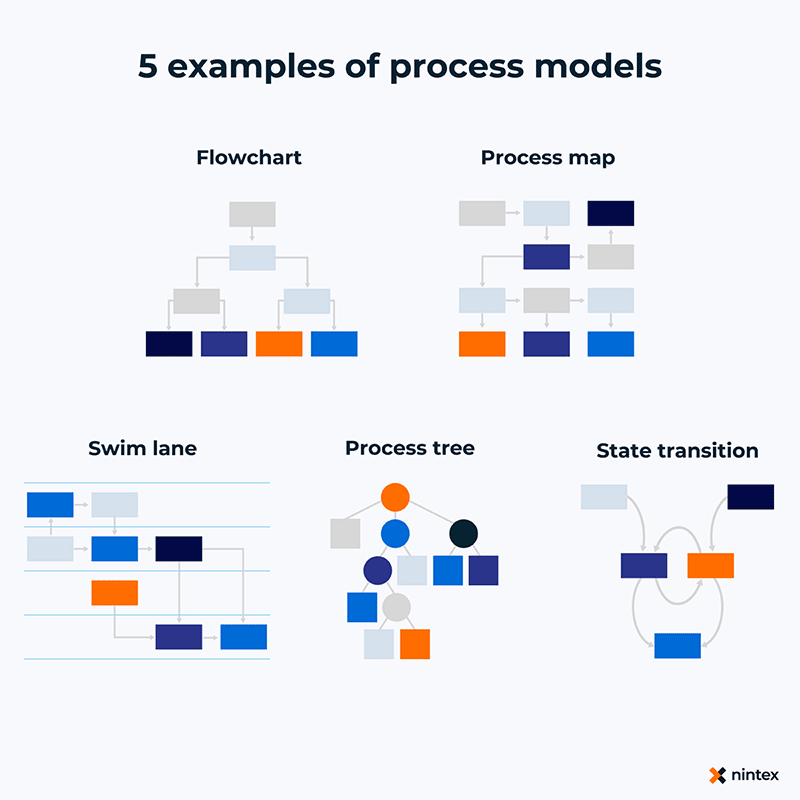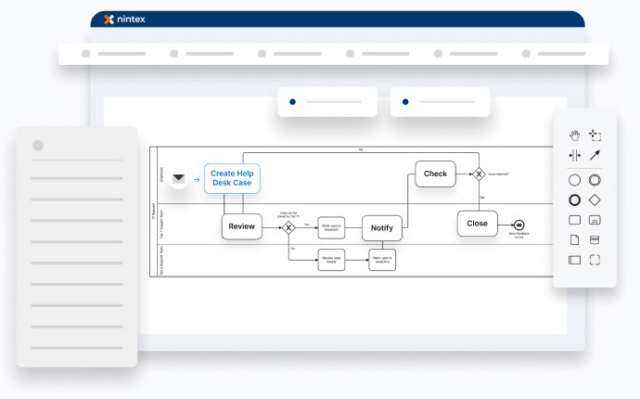Process modeling provides a visual map of your business operations, from flowcharts to process maps, to help you see the big picture and find better ways to work.
Process modeling definition

Process modeling is a way of visually representing the process and operations of a business. It can help managers make decisions about how to optimize their resources and improve efficiency in their processes through the development of a process model. Common examples of process models include flowcharts, process maps, swim lanes, and process trees—each offering a unique way to represent different workflows. Through process modeling, businesses can analyze costs, identify opportunities, manage risks, and enhance overall performance. Many process modeling solutions use business process model and notation (BPMN), an internationally recognized standard for documenting business processes.

What is BPMN?
Since its introduction in 2004, BPMN has been one of the most widely used formats for documenting business processes. Developed as a universal language, BPMN uses a set of symbols and notations to visually represent workflows within a business. These flow charts provide a clear view of how activities flow through an organization.
However, due to its complexity, many non-technical users without training in BPMN can find it challenging to understand large diagrams.
In organizations where employees need to access, own, and improve processes — understanding the process is key. For organizations to benefit from process ownership and improvement, employees must be able to understand and engage with the processes. For those with technical expertise in BPMN, this format can be a highly effective way to model your business processes.
Business modeling versus business process mapping and management
While business modeling and business process management (BPM) share similarities, there are key differences.
Both approaches visually represent processes to help businesses better understand and optimize them. However, business modeling tools typically use BPMN, which can be more complex and may require specialized knowledge. In contrast, BPM tools, like Nintex Process Manager, use simpler language and more accessible workflows, so that it’s easier for teams to collaborate and take ownership of processes.

Business modeling tools are more flexible for documenting complex processes, but they often rely on a few highly skilled employees who understand the BPMN. This reliance can limit the ability to hand the process back to less experienced employees. Nintex Process Manager bridges this gap by providing tools for ongoing process management, increased collaboration, and business-wide process excellence.
Unlock the full potential of your business processes with our expert-guided process modeling solutions
Watch our webinar to get started
What is process modeling?
Process modeling is a visual tool, often leveraging BPMN, to optimize business workflows. It provides a clear representation of an organization’s operations and processes that make it easier to identify opportunities for improvement.
By creating a graphical model, businesses can quickly spot inefficiencies, wasted resources, and opportunities to boost productivity. Process modeling also keeps organizations agile, allowing them to adapt to changing customer needs and market trends.
The benefits of process modeling?
Process modeling offers several key advantages, including a clearer understanding of how your business works and opportunities for improvement. This can be as straightforward as improving customer service or automating certain parts of the production line. Business process modeling also provides visibility over key operations and offers objective examples of how to streamline processes, so teams can work more efficiently together. By thinking critically about workflows, businesses can create more agile systems that support greater success for everyone involved.
Discover how to empower your frontline employees and enhance process management
Download our free eBook now!
What are the different business process model techniques?
Business process modeling is a powerful business too used to improve their operational efficiency. It involves analyzing, mapping, and documenting the activities that go into the production cycle to identify areas of improvement. There are several process modeling techniques businesses can use, common languages used within process modeling tools are
- Business process modeling notation (BPMN) – being the most common
- Universal process notation (UPN) is another common language used by business process modelers to create and analyze a wide variety of business processes. Less common than BPMN and slightly easier-to-understand language for visually representing flows of operations through graphical symbols, so that non-technical personnel can access the information and
- Flowchart technique is yet another way to organize and present ideas in business. Also using symbols for each process step such as circles, arrows, boxes, or other shapes, it creates a map of an entire process graphically.
Business process modeling serves as an integral tool for more technical teams comfortable with the BPMN language seeking to analyze, document, manage, and improve underlying processes.
With the recent introduction of process modeling BPMN capability, Process Manager is now the single source of process truth for everyone. It caters to the more technical teams with additional flexibility to model even the most complex processes with BPMN. Without forgoing the needs of the less technical teams that prefer a more simplified way to map, view, manage, and collaborate on processes.
Start your digital transformation. Learn how to plan, map and govern your business processes with Nintex Process Manager today!
Read more about Process Manager
